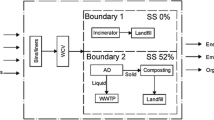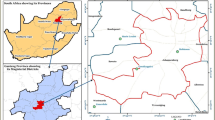Abstract
Potential environmental impacts associated with aerobic in-vessel composting and bioreactor landfilling were assessed using life cycle inventory (LCI) tool. LCI models for solid waste management (SWM) were also developed and used to compare environmental burdens of alternative SWM scenarios. Results from the LCI models showed that the estimated energy recovery from bioreactor landfilling was about 9.6 megajoules (MJ) per kilogram (kg) of waste. Air emissions from in-vessel composting contributed to a global warming potential (GWP) of 0.86 kg of CO2-equivalent per kg of waste, compared to 1.54 kg of CO2-equivalent from bioreactor landfill. Waterborne emissions contributing to aquatic toxicity is less coming from in-vessel composting than from bioreactor landfilling. However, emissions to air and water that contribute to human toxicity are greater for the composting option than for the landfill option. Full costs for in-vessel composting is about 6 times greater than for the landfilling alternative. Integration of individually collected commingled recyclables, yard wastes, and residual wastes with windrow composting and bioreactor landfilling produces airborne and waterborne emissions with the least environmental effects among the alternatives considered. It also yields greater energy savings due to the conversion of the landfill gas (LFG) to electrical energy than the option that diverts yard waste, food waste and soiled paper for aerobic in-vessel composting. However, this scenario costs 68% more than that where the commingled collection of wastes is integrated with in-vessel composting and conventional landfilling, owing to increased collection costs.




Similar content being viewed by others
References
Barlaz MA, et al (2003) Comparing recycling, composting and landfills. Biocycle 44.9:60–66
Camobreco V, et al (1999) Life-cycle inventory of a modern municipal solid waste landfill. Waste Manag Res 17:394–408
Clarke WP (2000) Cost-benefit analysis of introducing technology to rapidly degrade municipal solid waste. Waste Manag Res 18.6:510–524
Degobert P (1995) Automobiles and pollution. Society of Automotive Engineers, Warrendale, PA
Denison RA (1996) Environmental life-cycle comparisons of recycling, landfilling, and incineration: a review of recent studies. Annu Rev Energy Environ 21:191–237
EPA (1998) Full cost accounting in action: case studies of six solid waste management agencies. United States Environmental Protection Agency (US EPA), Washington, DC
EPA (2000) US. Biosolids technology fact sheet in-vessel composting of biosolids. United States Environmental Protection Agency (US EPA)
EPA (2005) Municipal solid waste in the United States: 2003 facts and figures. United States Environmental Protection Agency (USEPA), Washington, DC
Finnveden G, Johansson J, Lind P, Moberg R (2000) Life cycle assessments of energy from solid waste. Department of Systems Ecology, Stockholm University, August 2000. Available: http://www.infra.kth.se/fms/pdf/LCAofenergyfromsolidwaste.pdf
Johansson J (2006) A monetary valuation weighting method for life cycle assessment based on environmental taxes and fees. Department of Systems Ecology, Stockholm University, 29 May 1999. Available: http://www.infra.kth.se/fms/pdf/LCAvaluation.pdf
Kiely G (1998) Environmental engineering. McGraw-Hill Series in Chemical and Petroleum Engineering. McGraw-Hill, Malaysia
Kjeldsen P, Christophersen M (2001) Composition of Leachate from old landfills in Denmark. Waste Manag Res 19.3:249–256
Komilis D, Ham R (2004) Life-cycle inventory of municipal solid waste and yard waste windrow composting in the United States. J Environ Eng 130.11:1390
Krogmann U, Woyczechowski H (2000) Selected characteristics of Leachate, condensate and runoff released during composting of biogenic waste. Waste Manag Res 18.3:14
Matthews DD (2003) Environmental health sourcebook: basic consumer health information about the environment and its effect on human health, including the effects of air pollution, water pollution, hazardous chemicals, food hazards, radiation hazards, biological agents, household hazards. 2nd edn. Omnigraphics, Detroit, MI
O’Hern K, O’Neill T (2005) Composting finds its niche in Yellowstone national park. Biocycle 46.7:47–50
Tchobanoglous G, Theisen H, Vigil SA (1993) Integrated solid waste management: engineering principles and management issues. McGraw-Hill Series in Water Resources and Environmental Engineering. McGraw-Hill, New York
Themelis NJ, Kim YH (2002) Material and energy balances in a large-scale aerobic bioconversion cell. Waste management and research: the Journal of the International Solid Wastes and Public Cleansing Association, ISWA 20(Part 3):234–242
Westerholm R, Egeback KE (1994) Exhaust emissions from light- and heavy-duty vehicles: chemical composition, impact of exhaust after treatment, and fuel parameters. Environ Health Perspect 102(Suppl 4):13–23
White P, Franke M, Hindle P (1995) Integrated solid waste management: a lifecycle inventory. Blackie Academic & Professional, London, New York
Wilson EJ (2002) Life cycle inventory for municipal solid waste management. Waste Manag Res 20.1:16
Zimms M (2005) Research projects add value to Msw composting facility. Biocycle 46.8:36–38
Acknowledgment
This study was completed at the Michigan State University under the Fulbright Research Grant. This work has benefited from support from a number of individuals and organizations which is appreciated. Special thanks to the following individuals for information they shared: Mr. Peter Pasterz, Department Manager of the Office of Recycling and Waste Management, Mr. Anthony Boughton of the Land Management University Farms; Mr. Robyn Huber of Waste Management, Inc., and Mr. Charles Annett of Granger Waste.
Author information
Authors and Affiliations
Corresponding author
Rights and permissions
About this article
Cite this article
Cabaraban, M.T.I., Khire, M.V. & Alocilja, E.C. Aerobic in-vessel composting versus bioreactor landfilling using life cycle inventory models. Clean Techn Environ Policy 10, 39–52 (2008). https://doi.org/10.1007/s10098-007-0125-4
Received:
Accepted:
Published:
Issue Date:
DOI: https://doi.org/10.1007/s10098-007-0125-4




